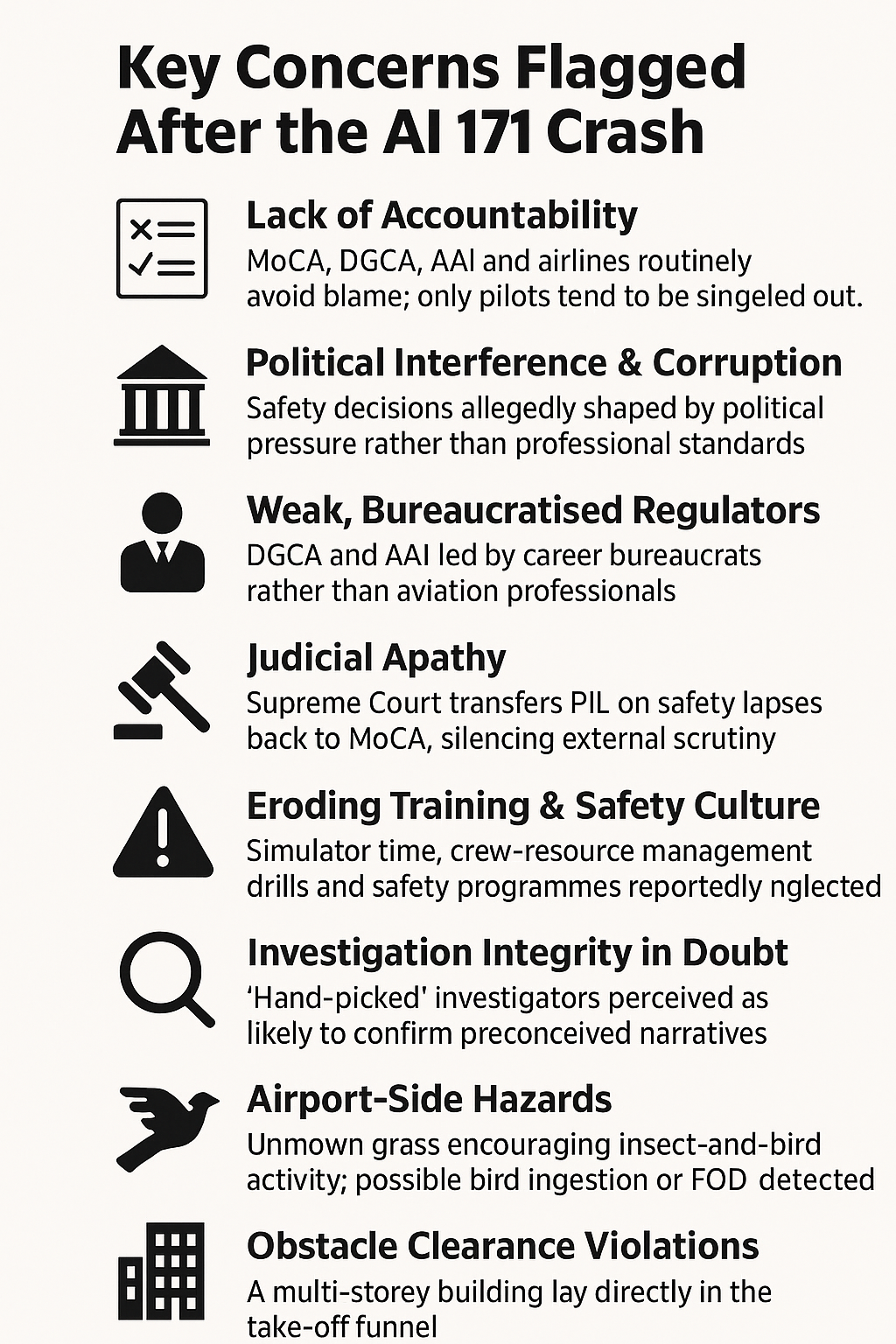Table of Contents
Context: The recent Air India Dreamliner crash (AI171) in Ahmedabad, Gujarat, has intensified scrutiny on the preparedness of the Aviation sector in India.
Current Growth Of Aviation Sector in India
- Domestic air travel is rebounding strongly with 6–10% annual growth.
- India is now the 3rd-largest aviation market in the world.
- Delhi’s Indira Gandhi International (IGI) airport ranks among the top 10 busiest airports worldwide (around 79 million passengers) and the 3rd busiest in Asia
What are the Different Concerns Associated with the Aviation Sector in India?
- Aircraft Safety and Airworthiness: Past issues with the Dreamliner include battery fires, engine icing, and manufacturing quality lapses.
- Experts fear gaps in aircraft maintenance, pre-flight checks, and crew training.
- Regulatory Oversight Gaps: The Directorate General of Civil Aviation (DGCA) faces staff shortages, limiting its ability to perform thorough safety audits.
- There are delays in responding to complaints, ramp inspections, and safety incident analysis.
- India’s aviation regulator is overstretched given the rapid fleet expansion.
- Shortage of Skilled Manpower: Pilot shortage is acute, especially for widebody aircraft.
- Training facilities and simulators are insufficient to meet demand.
- Skilled aircraft maintenance engineers (AMEs) and air traffic controllers (ATCOs) are also in short supply.
- Airport Infrastructure Challenges: Congestion at major airports like Delhi, Mumbai, and Bengaluru causes delays and potential safety risks.
- Tier-2 and Tier-3 airports lack essential infrastructure like fire safety, navigation aids, and bird hazard control.
- Airspace saturation in busy corridors increases mid-air risk.
- Supply Chain and Aircraft Availability: Delays in aircraft and engine deliveries due to global supply chain issues.
- Spare parts shortages increase aircraft-on-ground (AOG) time.
- Airlines are forced to cannibalize grounded jets for parts.
- Financial Fragility of Airlines: Margins are thin due to high fuel costs, leasing rates, and currency volatility.
- Many airlines are still recovering from COVID-era debts.
- High leasing costs persist due to weak contract enforcement (Cape Town Convention not fully implemented).
Key Concerns Flagged in Aviation Sector after AI 171 Crash in Ahmedabad

Check here: Ahmedabad Air India Plane Crash Incident
Key Government Initiative in Aviation Sector in India
- National Civil Aviation Policy (NCAP) – 2016 (MoCA): Enhances domestic aviation growth by rationalizing MRO taxation, supporting international expansion, and creating a more investor-friendly aviation ecosystem.
- NABH (NextGen Airports for Bharat) Nirman (MoCA): Focuses on modernizing airport infrastructure and increasing capacity to accommodate the rising number of air passengers.
- DigiYatra (MoCA): Introduces biometric-based, paperless travel to streamline airport processes and improve the passenger experience.
- GAGAN (GPS-Aided GEO Augmented Navigation) – ISRO + AAI: Enhances flight navigation accuracy and efficiency, improving operational safety through satellite-based augmentation.
- 100% FDI in Aviation (DPIIT): Permits full foreign ownership in greenfield airport projects and up to 49% in domestic airlines via the automatic approval route to attract global investment.
- Krishi Udan Scheme (MoCA): Supports air transportation of perishable agricultural products, aiming to boost farmers’ income and reduce post-harvest losses.
- Aircraft Leasing & Financing at GIFT City (IFSCA): Establishes a domestic hub for aircraft leasing and financing to reduce reliance on foreign leasing companies.
- Open Sky Policy (MoCA): Liberalizes international airspace access, encouraging greater global connectivity and foreign airline participation.
- Make in India – Aviation (DPIIT): Encourages domestic manufacturing of aircraft parts, systems, and airport infrastructure to strengthen the aviation supply chain and reduce imports.
- GST Introduced: A uniform 5% Integrated Goods and Services Tax (IGST) rate has been introduced for aircraft parts to promote India as a competitive global MRO hub.
Union Budget 2025–26: Key Initiatives to Strengthen India’s Aviation Sector
- Revamped UDAN Scheme: The government has announced a modified UDAN initiative aimed at strengthening regional air connectivity.
- The updated scheme will add 120 new destinations and is expected to serve an additional 4 crore passengers over the next 10 years.
- Infrastructure Development: Major plans include the expansion of Patna Airport and the development of a brownfield airport at Bihta in Bihar to enhance aviation infrastructure.
- Focus on Remote Areas: The UDAN scheme will also support the establishment of helipads and small airports in hilly regions, aspirational districts, and the Northeastern states, promoting access in underserved areas.
- Budget Allocations: The Ministry of Civil Aviation has been allotted ₹2,400.31 crore, a decrease from ₹2,658.68 crore in the previous year.
- Funding for the UDAN scheme has been reduced to ₹540 crore from ₹800 crore.
| About Regional Connectivity Scheme- Ude Desh ka Aam Naagrik (RCS-UDAN) |
Two components of UDAN
Significance of UDAN Scheme
|
Way Forward
- Infrastructure Modernization & Expansion: Accelerate the 200-airport target by 2025 and 4,000-aircraft fleet plan through $11 billion in infrastructure investments.
- Prioritize greenfield airports in underserved regions and upgrade existing hubs (e.g., Delhi, Mumbai) to handle rising traffic, which is projected to double by 2029.
- Legislative & Policy Reforms: Implement the Protection of Interest in Aircraft Objects Bill, 2025 to align leasing laws with global standards.
- MRO Ecosystem Development: Establish MRO clusters near major airports and streamline customs for faster spare-part clearances.
- Workforce & Safety Enhancements: Address 12–15% crew shortages through accelerated training programs and partnerships with global institutes.
- Mandate AI-driven safety protocols and fatigue management systems to reduce incidents like unstable approaches and runway overruns.
- Technological Integration & Global Collaboration: Adopt AI/ML for predictive maintenance and digital twin systems to optimize operations.
- Partner with firms like Airbus for “Make in India” aviation manufacturing, starting with the TATA-Airbus C-295 facility in Vadodara.
- Expand UDAN 5.0 to enhance last-mile connectivity through electric/hybrid aircraft pilots.


 Out-of-Pocket Health Expenditure, Reason...
Out-of-Pocket Health Expenditure, Reason...
 Treasury Bills (T-bills): RBI Cuts Holdi...
Treasury Bills (T-bills): RBI Cuts Holdi...
 Fisheries Sector in India, Current Statu...
Fisheries Sector in India, Current Statu...

























